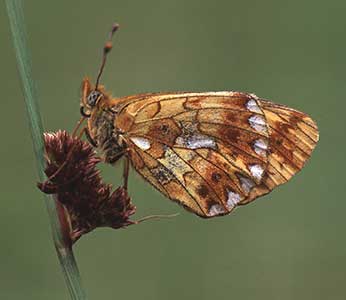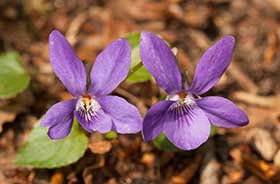Pearl-bordered Fritillary (Boloria euphrosyne)
When: May to mid-June
How many: Moderate numbers

- pearl-bordered fritillary
Pearl-bordered Fritillaries were once common and widespread in much of the English countryside. ‘Pearl-bordered Fritillaries...may be found in abundance in nearly all our southern woods’, said, W. Furneaux writing in 1897, whilst Richard South in 1906 confirmed the observation, saying ‘Pearl-bordered Fritillaries…fairly common in woods throughout England and Wales, and often abundant in some of the more extensive woodlands, especially in the southern counties.’
Yet today, Pearl-bordered Fritillaries have disappeared from many areas, victims of changed woodland management practices, and in particular, cessation of rotational hazel coppicing that previously ensured a succession of ideal, interlinked habitats that included quite large areas of open ground in which wild flowers could flourish.
Hazel poles then were in demand for use as thatching spars, and in a wide range of other country crafts. But as cheaper, man-made alternatives became increasingly available, coppices were progressively neglected, became overgrown, lost their rich wild flowers and also the butterflies that depended upon both open, well-lit conditions and the flowers.
In fact, Pearl-bordered Fritillaries are now one of the most endangered butterfly species in Britain, so-much-so that they are a high priority Biodiversity Action Plan (BAP) species singled out for special conservation attention.
But in the New Forest, Pearl-bordered Fritillaries are notably present and doing rather well.
First impressions are of a small, extremely nimble golden-orange coloured insect flitting about late-spring woodland rides, whilst closer examination reveals a network of fine black veins, crossbars and spots, and the seven silver pearls along the outer border of the hindwing’s under-surface that give the butterfly its name.

well-being of pearl-bordered fritillaries
Typically on the wing from mid-May until mid-June, Pearl-bordered Fritillaries are most active in bright light, for when the sun goes behind a cloud, they almost immediately seek shelter, often coming to rest amongst ride-side grasses. Even then, however, they often remain confidingly in sight, allowing very close approach.
The Pearl-bordered Fritillaries' current success in the New Forest is largely due to the work of a number of keepers who ensure that suitable habitat is available. This, though, is not quite as easy as it might sound, as the Pearl-bordered Fritillaries' requirements and dispersal mechanisms are incredibly complex, and for them to flourish requires regular management attention - which is probably why in most places the Pearl-bordered Fritillary has all but disappeared.
An abundance of common dog-violets – the Pearl-bordered Fritillary caterpillar food plant – are needed and also other plants such as bugle, late-flowering primroses, bluebells and speedwell on which the adults can feed.
Areas of bare ground are essential, too, as Pearl-bordered Fritillary caterpillars like to intersperse bouts of feeding with spells of basking in the sunshine – it apparently helps their digestion.
And if that’s not enough, sunlit routes are also necessary along which adult Pearl-bordered Fritillaries can disperse, for they will not willingly fly in shade or above the tree tops.
Forestry Commission work programmes now increasingly recognise Pearl-bordered Fritillary requirements, and try to accommodate them. Indeed, a chain harrow has been used along some of the woodland rides, pulled behind a quad bike, to disturb the ground, but not too much, and to clear away most of the vegetation, whilst leaving some relatively unscathed.
So hopefully, Pearl-bordered Fritillaries will continue to flourish in the New Forest, and brighten these woodlands for many years to come.
References:
Butterflies of the British Isles: J.A. Thomas
The Butterflies of Hampshire: Matthew Oates, John Taverner, David Green et al
The Millennium Atlas of Butterflies in Britain and Ireland: Jim Asher, Martin Warren, Richard Fox, Paul Harding, Gail Jeffcoate and Stephen Jeffcoate
The Butterflies of the British Isles: Richard South
British Butterflies and Moths: W. Furneaux
More links
Other related links
Search this site

Sadly, 58 animals were killed - 35 ponies, 13 cows, 8 donkeys and 2 sheep, whilst a further 32 were injured - 3 pigs, 9 donkeys, 11 cows and 9 ponies.
(Forty-three accidents occurred in daylight, 15 at twilight and 101 in the dark. Twenty-seven accidents were not reported by the driver involved).
Here's just one horrific example - Three donkeys killed in collision with van at notorious New Forest blackspot (Advertiser and Times)
Sika deer continue to engage in rutting behaviour, and will do so until December.
Pigs seek out the remains of the acorn crop.
Beech leaves are transformed into a magnificent mosaic of glorious reds and golds. Other deciduous trees, too, take on an autumnal cloak before their leaves fall.
Dragonflies can occasionally be seen on the wing on bright days early in the month.
December
Foxglove leaves survive the winter at ground level, and offer the prospect of colourful summer blooms to come.
Redwings and fieldfares, autumn and winter visitors, gorge on haws and holly berries.
Great grey shrikes and hen harriers hunt over the heaths and other open spaces.
Honeysuckle by the end of the month often shows welcome signs of new growth.

